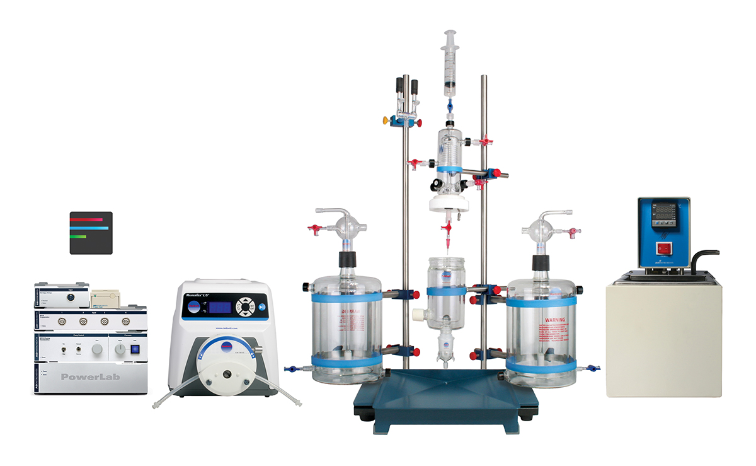
We talk to ADInstruments Research Product Manager, JC Tan, about redesigning the Langendorff Apparatus for improved usability and flexibility by making it more compact and less complicated for researchers.
When developing new therapies for recovering from a heart attack or understanding the physiology behind heart disease, researchers need to know which responses come from the heart rather than surrounding tissues and organs. The Langendorff technique, also known as the isolated perfused heart technique, removes the heart from these influences while maintaining its function ex vivo via retrograde perfusion through the aorta. This technique has been critical to the field of cardiovascular physiology and pharmacology.
To support our customers performing cardiovascular research, we have designed a new and more compact Rodent Langendorff Apparatus. Our project lead, Dr. JC Tan, explains why he was excited to redesign the Langendorff apparatus, and what separates this new system from traditional Langendorff apparatuses.
In this article, we cover:
- How modularity improves the experience of users across a variety of research requirements
- How high-quality materials make maintenance easy
Related Article: Collect data from closer to the heart for more accuracy with the Direct Perfusion Core »
The heart of the matter
Before working at ADInstruments, JC completed his Ph.D. in Sydney, Australia, at the Graduate School of Biomedical Engineering of the University of New South Wales in conjunction with Victor Chang Cardiac Research Institute. During his studies, JC was using and responsible for maintaining laboratory equipment - including a Langendorff apparatus. After several years at ADInstruments as a support specialist, it became clear that Langendorff users had similar concerns, which most available apparatuses did not fully address.
“In supporting our customers across the years and understanding the features they were looking for, I realized there was a gap. Because the Langendorff technique is such a staple methodology, few commercial companies have improved or innovated their designs. Hence the Langendorff apparatus design has more or less stayed the same throughout the years.”
Most Langendorff systems, in JC’s experience, are designed by an engineer rather than a user. Innovation in this space meant prioritizing features that would improve data quality, ease of use, and modularity to suit users with simple and complex experimental designs.
“I was in a unique place where I had familiarity with what was technologically possible as well as the requirements for the application. Combining these fields of expertise gave me insight into how we could improve the overall user experience and innovate our products rather than continuing to provide a product that has not seen much development through the years.”
In conjunction with expertise and support experience from Radnoti, the ADInstruments Rodent Langendorff Apparatus was developed. This design prioritizes a modular construction to suit researchers with various experimental needs, a compact surface area to minimize bench space requirements, and ease of maintenance with high-quality materials and autoclavable glassware. And with the addition of the Direct Perfusion Core, researchers can measure data from closer to the heart.
Find out more about the Rodent Langendorff Foundation System and request a quote »
Finding a flexible design
Modularity
Commercially available Langendorff systems generally fall into one of two categories: compact or complex. Both approaches have their advantages.
A compact Langendorff Apparatus is made from plastic, or acrylic pieces, which fit together into one solid unit after assembly. Once assembled, the apparatus cannot be altered. “A compact model can be good for a beginner, but it does reduce the flexibility in terms of use because it's trying to simplify the model,” says JC. “If someone wanted to get serious with Langendorff, tweaking and modifying to suit their experiment, then the compact design would limit that user.”
With a more complex Langendorff, such as the Radnoti Langendorff System, the researcher can customize the system to their requirements. Each apparatus component attaches separately to a support stand, allowing the researcher to customize configuration and height. “There is much more flexibility in designing where the components sit. You can build a very complex system later, even expanding it to quite a large system as well.”
Many experimental designs do not require this amount of customization. “I have seen a lot of laboratory-built Langendorffs, as many commercial solutions might be too complex for their needs.”
To address the gap between these two designs, the ADInstruments Rodent Langendorff Apparatus incorporates elements from both for a modular yet compact solution. “This Langendorff allows you to scale from it being extremely simple to more sophisticated as you need.”
JC is confident that this design enables researchers to do their best work and will grow with their experimental needs. Researchers can begin with a simplified apparatus, such as a single reservoir design, and expand the same apparatus with optional components, such as adding recirculation. Other easy customization includes hanging the heart on the left or right side of the apparatus.
Modularity also reduces the cost of replacement in the case of damage. In the case of most compact, static Langendorffs, researchers must repurchase the entire apparatus if any piece becomes damaged. Should the need arise, any individual component of the ADInstruments Rodent Langendorff is replaceable.
“Because of its versatility and capacity for customization, I feel like users could customize it to exactly how they want to run their experiments. It provides a great starting point. Users who want a very simple system can start with that. However, users who want more complexity can chat with us about building on top of it to suit their needs.”
Related Product: PowerLab C Rodent Langendorff Foundation System »
High-quality materials
The ADInstruments Rodent Langendorff is made with high-quality borosilicate glassware. All of the glassware is double-walled, and heated water maintains the temperature of the apparatus. According to JC, glass is a superior material to acrylic or plastic for several reasons. Compact Langendorff systems are normally made with acrylic or plastic, which can become yellow and develop fine cracks with high temperatures.
“Glass, although it might seem fragile, is a very good material for this kind of work. The surface doesn't crack or yellow. Glass is also inert; you never know whether there is potential leaching from the acrylic into the perfusate.”
Transparent glassware increases the visibility of the perfusate pathway, and the design reduces the number of opaque elements in the apparatus. This visibility is critical for detecting foreign material in the perfusate before it enters the heart, allowing researchers to prevent blockage and ischemia from affecting their data.
“Making it entirely out of glass - and trying to limit the number of pieces that are made out of nontransparent materials - will help researchers visualize the perfusate pathway,” JC says. “From a user’s perspective, you want to avoid introducing things into the heart that are undesired or unseen. This includes air bubbles or particulate matter. Yellowing, stainless steel components, and opaque components that are part of the circuit would prevent you from seeing these things.”
“Glass gives you a very clear visual of the entire perfusion circuit. If there's anything in the circuit, you can see it. Because the system is modular, you could halt the circuit or redirect the perfusate to prevent air bubbles from reaching the heart.”
Outside the glass components, the metal support stands are made from the highest grade medical grade stainless steel, which is highly corrosion resistant. This apparatus is also RoHS-compliant, matching ADInstrument’s commitment to reducing hazardous substances in electrical and scientific equipment.
Maintaining your Langendorff
After assisting years of support cases, JC knew it was important to prioritize the ease of maintenance for this apparatus. As retrograde perfusion can often be messy, the ADInstruments Rodent Langendorff Apparatus has features designed to improve cleanliness.
The Stand Base Spill Tray (also sold separately) reduces the need to wipe down your lab bench. Designed to be compatible with all Radnoti stand bases or support rods, the slopped surface of this tray guides liquid runoff to a drain connected to rubber tubing.
Radnoti glassware is also autoclavable. The modularity of the apparatus means that researchers can autoclave each glass component individually, ensuring it is thoroughly clean.
Final comments
“I wish I had had the whole PowerLab system when I was studying. There is definitely a huge difference to the lab-built system I was using. I packed a lot of powerful features into the apparatus. Once you start thinking of how you want to evolve it in the future, it will be quite easy to do so.”
ADInstruments is dedicated to making science easier and innovating the technology researchers rely on. The ADInstruments Rodent Langendorff Apparatus is our modular yet compact solution ideal for retrograde perfusion of isolated rodent hearts (mice, rats, guinea pigs, and small rabbits).
Our support team is passionate about research. Please contact your local representative if you have any questions about how to customize our products to fit your application.
Find out more about this Langendorff System and request a quote »
Dr. JC Tan completed his Ph.D. in Sydney, Australia, at the Graduate School of Biomedical Engineering of the University of New South Wales in conjunction with Victor Chang Cardiac Research Institute. He is currently a Research Product Manager with ADInstruments.
Related Products:
ADInstruments Rodent Langendorff Apparatus »
PowerLab C Rodent Langendorff Foundation System »
Stand Base Spill Tray »
Radnoti Langendorff Systems (Constant Pressure or Flow) »
